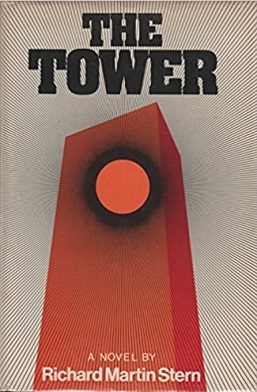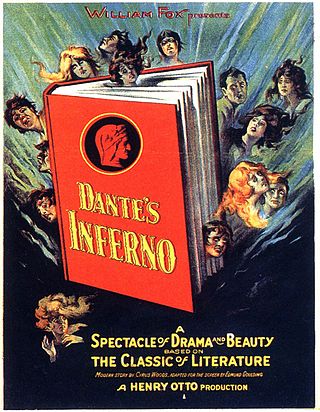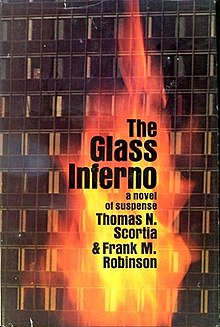
The Towering Inferno is a 1974 American disaster film directed by John Guillermin and produced by Irwin Allen, featuring an ensemble cast led by Paul Newman and Steve McQueen. It was adapted by Stirling Silliphant from the novels The Tower by Richard Martin Stern and The Glass Inferno by Thomas N. Scortia and Frank M. Robinson. In addition to McQueen and Newman, the cast includes William Holden, Faye Dunaway, Fred Astaire, Susan Blakely, Richard Chamberlain, O. J. Simpson, Robert Vaughn, Robert Wagner, Susan Flannery, Gregory Sierra, Dabney Coleman and Jennifer Jones in her final role.

A disaster film or disaster movie is a film genre that has an impending or ongoing disaster as its subject and primary plot device. Such disasters may include natural disasters, accidents, military/terrorist attacks or global catastrophes such as a pandemic. A subgenre of action films, these films usually feature some degree of build-up, the disaster itself, and sometimes the aftermath, usually from the point of view of specific individual characters or their families or portraying the survival tactics of different people.

Earthquake is a 1974 American ensemble disaster drama film directed and produced by Mark Robson and starring Charlton Heston and Ava Gardner. The plot concerns the struggle for survival after a catastrophic earthquake destroys most of the city of Los Angeles, California.

The Great Boston Fire of 1872 was Boston's largest fire, and still ranks as one of the most costly fire-related property losses in American history. The conflagration began at 7:20 p.m. on Saturday, November 9, 1872, in the basement of a commercial warehouse at 83–87 Summer Street. The fire was finally contained 12 hours later, after it had consumed about 65 acres (26 ha) of Boston's downtown, 776 buildings and much of the financial district, and caused $73.5 million in damage. The destruction to the buildings was valued at $13.5 million and the personal property loss was valued at $60 million. In the end, at least 30 people died, including 12 firefighters.

On Monday, December 1, 1958, a fire broke out at Our Lady of the Angels School in Chicago, Illinois, shortly before classes were to be dismissed for the day. The fire originated in the basement near the foot of a stairway. The elementary school was operated by the Archdiocese of Chicago and had an enrollment of approximately 1600 students. A total of 92 pupils and 3 nuns ultimately died when smoke, heat, fire, and toxic gases cut off their normal means of egress through corridors and stairways. Many more were injured when they jumped from second-floor windows which, because the building had a raised basement, were nearly as high above ground as a third floor would be on level ground.
Skyscrapers are frequently featured in films for their impressive appearance and potent symbolism. They convey an impression of power – an old movie and TV cliché starts with the outside view of a skyscraper with a voice-over conversation, continuing inside the luxurious office of a tycoon or crime boss.

The Garley Building fire took place on 20 November 1996 in the 16-storey Garley commercial building located at 232–240 Nathan Road, Jordan, Hong Kong. The fire caused 41 deaths and 81 injuries. It is considered the worst building fire in Hong Kong during peacetime. The fire damaged the bottom two floors and the top three floors of the building, while the middle floors remained relatively intact.

Nothing Lasts Forever is a 1979 action thriller novel by American author Roderick Thorp, a sequel to his 1966 novel The Detective. The novel is mostly known through its 1988 film adaptation Die Hard, starring Bruce Willis. In 2012, the book was brought back into print and released as an ebook for the 24th anniversary of the film.
"The Secret Code" is the 117th episode of NBC sitcom Seinfeld. This was the seventh episode of the seventh season. It aired on November 9, 1995. In this episode, George is unwilling to share his ATM code with his fiancée Susan, and finds himself entrapped in awkward social situations after he loses his talent for lying. Meanwhile, Elaine finds herself infatuated with a man because he cannot recall their first meeting, Jerry's plans to appear in a television commercial are repeatedly frustrated by his foot falling asleep, and Kramer tries to help out the local fire department.

The Cloquet Fire was an immense forest fire in northern Minnesota, United States in October 1918, caused by sparks on the local railroads amid dry conditions. The fire left much of western Carlton County devastated, mostly affecting Moose Lake, Cloquet, and Kettle River. Cloquet was hardest hit by the fires; it was the worst natural disaster in Minnesota history in terms of the number of casualties in a single day. It is also the third-deadliest wildfire in recorded history, behind the Peshtigo fire of 1871 and a 1936 wildfire that occurred in Kursha-2.

The Tower is a 1973 novel by Richard Martin Stern. It is one of the two books drawn upon for the screenplay Stirling Silliphant wrote for the 1974 movie The Towering Inferno, the other being the 1974 novel The Glass Inferno by Thomas N. Scortia and Frank M. Robinson.

Towering Inferno is an Atari 2600 game designed by Jeff Corsiglia and programmed by Paul Allen Newell and released by US Games in 1982. The player controls a fireman going through a burning skyscraper to save victims and put out the fires. The game was produced under a licence obtained from 20th Century Fox by Quaker Oats, the parent company of US Games, for the video game rights to the movie of the same name.

Firehouse Dog is a 2007 American family film produced by Regency Enterprises and distributed by 20th Century Fox. Directed by Todd Holland, it stars Josh Hutcherson, Bruce Greenwood, Dash Mihok, Steven Culp and Bill Nunn. It was released April 4, 2007, in the U.S.

Four Leaf Towers is a high-rise residential complex located in Houston, Texas, United States, on San Felipe Street adjacent to the Uptown Houston district. They were designed by architect Cesar Pelli.

The Grover Shoe Factory disaster was an industrial explosion, building collapse and fire that killed 58 people and injured 150 when it leveled the R. B. Grover shoe factory in Brockton, Massachusetts on March 20, 1905. Following a boiler explosion, the four-story wooden building collapsed and the ruins burst into flames, incinerating workers trapped in the wreckage.

Dante's Inferno is a 1924 American silent drama film directed by Henry Otto that was released by Fox Film Corporation and adapted from Inferno, part of Dante Alighieri's epic poem Divine Comedy. The film mixes material from Dante's "Inferno" with plot points from Charles Dickens' A Christmas Carol. The book was filmed earlier in 1911 in Italy as L'Inferno, and Fox later remade the film in 1935, again as Dante's Inferno, starring Spencer Tracy in the lead role.

The UpStairs Lounge arson attack, sometimes called the UpStairs Lounge Fire, occurred on June 24, 1973, at a gay bar called the UpStairs Lounge located on the 2nd floor of the 3-story building at 604 Iberville Street in New Orleans, Louisiana, in the United States. 32 people died and 15 were injured as a result of fire or smoke inhalation. The official cause is still listed as "undetermined origin". The primary suspect, a gay man with a history of psychiatric impairment named Roger Dale Nunez who had been ejected from the bar earlier in the day, was never charged and died by suicide in November 1974.

Grand Exit is a 1935 American detective mystery film with comedy elements, directed for Columbia Pictures by Erle C. Kenton, with screenplay by Bruce Manning and Lionel Houser, based on a story by Gene Towne and Graham Baker. The leads, in their second film together, are Edmund Lowe and Ann Sothern, with supporting players Onslow Stevens, Robert Middlemass and Wyrley Birch.

The Third Alarm is a 1930 American pre-Code drama film directed by Emory Johnson. The film is based on the original story by Emilie Johnson and is set in San Francisco, California. The photoplay stars Anita Louise, James Hall, and Jean Hersholt. The movie was released on November 30, 1930, by Tiffany-Stahl Productions
















